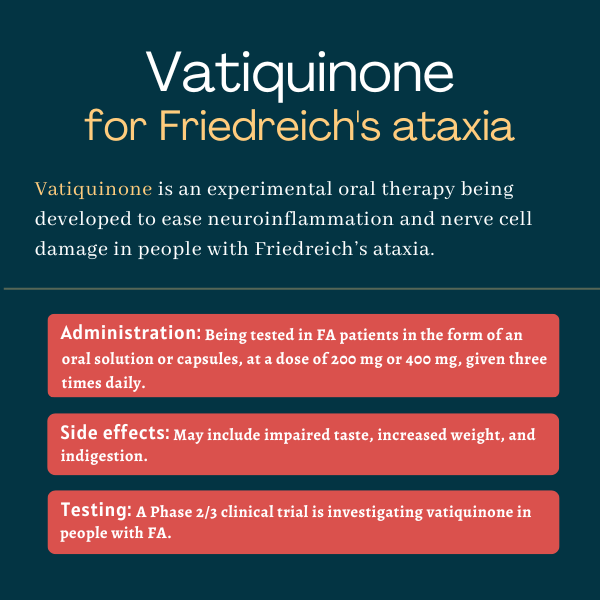FAQs about Vatiquinone
Vatiquinone is being investigated in the extension part of a Phase 2/3 trial in people with Friedreich’s ataxia as well as a Phase 2 study in children with the disease. While it’s shown promise in earlier trials, more data is needed to establish vatiquinone’s safety and efficacy. Therefore, it’s too early to know if or when the therapy might be approved by the U.S. Food and Drug Administration.
Vatiquinone is an experimental therapy that’s not yet approved for treating Friedreich’s ataxia (FA). It’s designed to limit neuroinflammation and nerve cell damage in people with FA by blocking the activity of an enzyme called 15-lipoxygenase. In clinical trials, this has led to significant reductions in disease progression.
Because vatiquinone is still in the early stages of development, studies examining its interaction with alcohol are lacking. Patients who wish to drink alcohol while taking the medication should discuss this issue with their doctors.
In clinical trials, significant benefits of vatiquinone, such as reduced face and neck (bulbar) symptoms, better upper limb coordination, and improved neurological function, were seen after six months. Because Friedreich’s ataxia has a variable disease course, some patients may see benefits earlier than others. More data is needed to have an idea about how soon patients may see benefits with treatment.
The most common side effects of vatiquinone reported in Friedreich’s ataxia clinical trials involved the gastrointestinal tract and included impaired taste, increased weight, and indigestion. It’s recommended that patients speak with their healthcare providers to understand how the medication may affect them. They should also report any unanticipated side effects of vatiquinone to their doctors.
Related Articles

 Fact-checked by
Fact-checked by 







